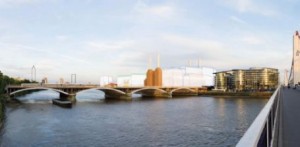Author: Cyril Richert
The Council is asking now people to comment on the draft document for local views within the borough. This document aims at defining the different types of view that have some local significance and deserve protection within the borough.
We have doubts on the values of the document as most of it is focused on Nine Elms and the Battersea Power Station, and those views are going to change (as acknowledged in the document). There is no mention at all of Clapham Junction and the views within the Conservation Area (no need to be protected anymore?).During the Planning Forum meeting in April 2013, Martin Howell, Group Planner, said that there will be a shorter list of views. This is indeed short, as according to the document we have now 7 views instead of nearly 40. However this seems inaccurate as the following pages of the document show only 6 views instead of 7. In addition, with the exception of view 1 (Putney Bridge) and view 2 (Battersea Bridge), all the rest focus on the Battersea Power Station…. which is going to change probably sooner rather than later. And that is even acknowledged on page 14:
“This view will change as the redevelopment of Nine Elms takes place. One Nine Elms, when constructed, will be prominent at the centre of the view next to the existing Vauxhall Tower. Next to this will be the towers proposed as part of the redevelopment of the New Covent Garden Market site. The emerging tall buildings cluster at Vauxhall will eventually form a dramatic focal point in the distance.“
On view 4 (p16) it says “It is important that the distinctive silhouette of the four iconic chimneys of the Power Station should remain as a dominant feature on the skyline.”
The “protected view” has already been damaged by planning applications; the photo montage (above) shows clearly that with the new developments surrounding the power stations, the view of more than half of the two chimneys on the south side of the building will disappear.
Therefore in our views, there is only 3 different focal points to protect. With the views on the Battersea Power Station already partly gone, there is only two remaining. What is the point of the Local View document?
The Council is making a U-turn on its policy for visual representation
We noticed that there is here a U-turn from the previous policy as expressed in the Development Management Policies Document.
In the Appendix (para 59) it says
“The guidance suggests the equivalent of a 50 mm lens on a 35 mm format camera may be appropriate but that different tasks require different approaches.”
This contradicts the DMPD, para 2.49 page 23:
“The use of wide-angle lenses, for example, can distort perspective and distance, and thus the relationship between the foreground and background, and this will not be acceptable”.
The DMPD guidance seemed to have been set following the government inspector’s report on the Ram Brewery inquiry, who wrote (p7):
“Guidance on how to prepare AVRs consistently indicates that images should ideally be made within a 40° field of view (FOV); beyond that, the perceived shapes of surrounding buildings may be distorted […] the use of a wide angle lens has the effect of distorting perspective and distance, and thus the spatial relationship between foreground and background. Existing buildings, and therefore the new ones, appear further away or smaller than they are or would be in reality, This was particularly apparent to me when I compared the AVRs to the actual views from the same viewpoints and is also demonstrated in the Wandsworth Society’s comparable 40º AVRs.
[…] the applicant’s AVRs cannot be taken as accurately representing what would be seen by the human eye.”
And in case we have not understood enough that wide angle images are perfectly fine, the proposed document on local view concludes in para. 65:
“Overall the LVMF guidance and industry experts suggest that wider angle lenses can be used particularly for townscape analysis as they can portray peripheral information about a view that a closer image would not.”
There is absolutely no doubt at all that this aim to validate the view of most developers with tall building schemes where the usage of wide-angle lenses minimises the impact of the development on the surrounding.
In explaining their methodology, the domain expert company Miller Hare explains:
“In the simple case the lens selection will be that which provides a comfortable Viewing Distance. This would normally entail the use of what most photographers would refer to as a “standard” or “normal” lens, which in practice means the use of a lens […] between about 40 and 58 mm.”
Miller Hare explains that the use of a wide angle lens is meant to provide additional information such as context, number of buildings, etc. It does not say that this is what the naked eye would see when the development is complete.
It is important that it is recognised that this is not a substitute for viewing the images in the field. In any event, a reasonable representation should be sufficient in printed form never mind in screen form it is after all not going to be realistic.
Therefore the policy and guidance should clearly state that the aim should be for understandable and unbiased representation. When used for the purpose of illustration, especially for the public, it must be clearly specified that this is provided by the developer and may not represent what will be seen by a naked eye.
Filed under: Nine Elms & Battersea Power Station, Planning strategy
![]()

